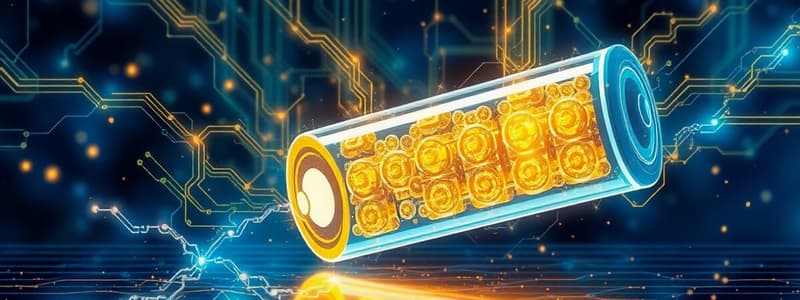Podcast
Questions and Answers
What is the primary characteristic that differentiates primary batteries from secondary batteries?
What is the primary characteristic that differentiates primary batteries from secondary batteries?
- Primary batteries generate a higher voltage.
- Secondary batteries contain a liquid electrolyte.
- Secondary batteries can be recharged while primary batteries cannot. (correct)
- Primary batteries use lithium as a key component.
Which battery is recognized as the first true battery according to historical accounts?
Which battery is recognized as the first true battery according to historical accounts?
- The Daniell Cell
- The Baghdad Battery
- The Lithium Ion Battery
- The Voltaic Pile (correct)
In the Daniell Cell, which reaction occurs at the cathode?
In the Daniell Cell, which reaction occurs at the cathode?
- Zn2+(aq) + Cu(s) → Zn(s) + Cu2+(aq)
- Cu2+(aq) + 2e– → Cu(s) (correct)
- Zn(s) → Zn2+(aq) + 2e–
- 2H+(aq) + 2e– → H2(g)
What is a significant advantage of lithium as a material in modern batteries?
What is a significant advantage of lithium as a material in modern batteries?
What was a major consequence of the changes made in the Daniell Cell compared to the Voltaic Pile?
What was a major consequence of the changes made in the Daniell Cell compared to the Voltaic Pile?
Which of the following represents a significant challenge facing today's Li-ion batteries?
Which of the following represents a significant challenge facing today's Li-ion batteries?
Which invention occurred first in battery history according to the timeline provided?
Which invention occurred first in battery history according to the timeline provided?
What is an example of a 'beyond-Li-ion' technology mentioned?
What is an example of a 'beyond-Li-ion' technology mentioned?
What was the primary purpose of the Baghdad battery as understood from historical context?
What was the primary purpose of the Baghdad battery as understood from historical context?
Which of the following statements correctly describes the net reaction at the anode of the Daniell Cell?
Which of the following statements correctly describes the net reaction at the anode of the Daniell Cell?
What is a key advantage of using lithiated graphite over pure lithium in battery electrodes?
What is a key advantage of using lithiated graphite over pure lithium in battery electrodes?
What does the formula ∆rG = –zFEcell represent in the context of lithium-ion batteries?
What does the formula ∆rG = –zFEcell represent in the context of lithium-ion batteries?
What issue arose with the early lithium-TiS2 battery developed by Stanley Whittingham?
What issue arose with the early lithium-TiS2 battery developed by Stanley Whittingham?
Which material can lithium ions occupy in the lithium cobalt oxide (LiCoO2) structure?
Which material can lithium ions occupy in the lithium cobalt oxide (LiCoO2) structure?
What electrical voltage is generated by the reaction between lithiated graphite and LiCoO2 during discharge?
What electrical voltage is generated by the reaction between lithiated graphite and LiCoO2 during discharge?
What unintended reaction occurs between the liquid electrolyte and the electrodes in a lithium-ion battery?
What unintended reaction occurs between the liquid electrolyte and the electrodes in a lithium-ion battery?
During charge cycles, what happens to the lithium ions in LiCoO2?
During charge cycles, what happens to the lithium ions in LiCoO2?
What breakthrough did Akira Yoshino achieve in lithium battery technology?
What breakthrough did Akira Yoshino achieve in lithium battery technology?
What is a critical limitation of lithium-ion battery technology as highlighted in the discussion?
What is a critical limitation of lithium-ion battery technology as highlighted in the discussion?
In the context of lithium-ion batteries, what does the term 'dendrites' refer to?
In the context of lithium-ion batteries, what does the term 'dendrites' refer to?
Flashcards
Lithium's Reactivity
Lithium's Reactivity
Lithium is highly reactive and readily loses electrons, making it suitable for batteries.
Energy in Lithium Reactions
Energy in Lithium Reactions
Chemical reactions involving lithium oxidation release a significant amount of energy due to its reactivity.
Gibbs Free Energy and Cell Potential
Gibbs Free Energy and Cell Potential
The change in Gibbs Free Energy (∆rG) is proportional to the cell potential (Ecell), emphasizing the high energy output of lithium batteries.
Stanley Whittingham's Li-TiS2 Battery
Stanley Whittingham's Li-TiS2 Battery
Signup and view all the flashcards
Dendrite Problems
Dendrite Problems
Signup and view all the flashcards
Graphite and Li-Ion Batteries
Graphite and Li-Ion Batteries
Signup and view all the flashcards
LiCoO2 Positive Electrode
LiCoO2 Positive Electrode
Signup and view all the flashcards
Cell Voltage in Li-ion Batteries
Cell Voltage in Li-ion Batteries
Signup and view all the flashcards
Li-ion Battery Charging and Discharging
Li-ion Battery Charging and Discharging
Signup and view all the flashcards
Solid-Electrolyte Interphase (SEI)
Solid-Electrolyte Interphase (SEI)
Signup and view all the flashcards
What is a galvanic device?
What is a galvanic device?
Signup and view all the flashcards
What is the significance of the Baghdad battery?
What is the significance of the Baghdad battery?
Signup and view all the flashcards
What is the Voltaic Pile?
What is the Voltaic Pile?
Signup and view all the flashcards
What is the Daniell Cell?
What is the Daniell Cell?
Signup and view all the flashcards
What's the difference between primary and secondary batteries?
What's the difference between primary and secondary batteries?
Signup and view all the flashcards
Why is lithium used in most modern batteries?
Why is lithium used in most modern batteries?
Signup and view all the flashcards
When were lithium-ion batteries invented?
When were lithium-ion batteries invented?
Signup and view all the flashcards
What are some challenges facing Li-ion batteries today?
What are some challenges facing Li-ion batteries today?
Signup and view all the flashcards
What are “Beyond-Li-ion” technologies?
What are “Beyond-Li-ion” technologies?
Signup and view all the flashcards
What is Electrochemistry?
What is Electrochemistry?
Signup and view all the flashcards
Study Notes
Lecture Overview: Frontiers in Chemistry - Batteries
- This lecture focuses on the history and functioning of batteries.
- The lecture discusses electrochemical principles, the development of lithium-ion batteries, and potential future battery technologies.
- The presentation includes various types of batteries and their related chemical reactions.
- The lecture details the evolution of battery technology, from early inventions to modern lithium-ion batteries.
Learning Outcomes
- Students will understand the fundamental operating principles of batteries.
- Students will grasp why lithium is predominantly used in modern batteries.
- Students will learn about the innovations that led to lithium-ion battery technology.
- Students will identify challenges related to current lithium-ion batteries.
- Students will be introduced to emerging "beyond-lithium-ion" battery technology.
- Students will gain knowledge about energy storage methods.
History of Batteries
- Earliest battery: Voltaic pile (1799) using zinc and copper electrodes in salt water.
- Baghdad battery (1936): an ancient artifact potentially used as a battery.
- Further Developments: Several advancements are described, including improvements in types of cells, like the Daniell cell (1836). and the progression to different cell types based on materials.
- Transition to more modern batteries including Nickel cadmium, and alkaline.
- Lithium-ion batteries are later innovations.
Lithium-ion Batteries
- Lithium is used widely because it is highly electropositive, and its reactions are energetically favorable.
- High energy output per weight.
- Tesla Model S Battery Example: This vehicle demonstrates the significant energy storage capabilities of modern lithium-ion batteries in practice.
Stanley Whittingham's Work
- Initial research on lithium-ion batteries involved using TiS2.
- Challenge: Lithium metal dendrites, which caused short circuits.
Akira Yoshino's Advancements
- Developed graphite electrodes.
- This modification produced much more stable batteries.
LiCoO2 Positive Electrodes
- Li+ ions move within a layered structure in LiCoO2.
- Significant voltage increase over other earlier technologies.
Modern Lithium-Ion Battery Operation
- Charging and Discharging Reactions are given
- Half the lithium ions can be removed, weakening the structural integrity of the battery.
Solid-Electrolyte Interphases (SEIs)
- Protective layer on electrodes, created by the chemical reaction between electrolyte and electrodes.
- Protect electrodes from degradation, ensuring prolonged service life.
- Maintains conductivity for the Li ions.
Nobel Prize in Chemistry (2019)
- John B. Goodenough, M. Stanley Whittingham, and Akira Yoshino jointly received the Nobel Prize for their pioneering work on lithium-ion battery technology.
Battery Challenges/Issues
- Various issues with different types of battery components.
- Corrosion
- Short Circuits
- Structural Degradation
- Other considerations impacting battery performance are detailed to further show the complexity of modern batteries.
Beyond Lithium-ion Technology
- Exploring alternative electrode materials (e.g., sulfur, oxygen).
- Exploring alternative electrode chemistries using different metals (sodium, potassium, calcium, etc.).
- Replacing lithium with potentially safer materials with similar reactivity and electrochemical capabilities.
- New research required to ensure the viable use of an alternate technology.
Studying That Suits You
Use AI to generate personalized quizzes and flashcards to suit your learning preferences.





